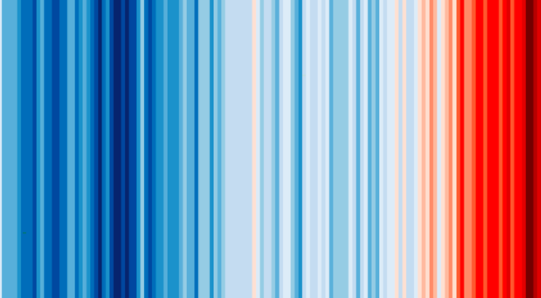Sign up to receive the weekly Climate Beat newsletter in your inbox.
Last week, hundreds of meteorologists and climate scientists around the world united to send a message about climate change. Under the “#ShowYourStripes” campaign, meteorologists used a simple blue-and-red striped pattern, designed by UK-climate scientist Ed Hawkins, to demonstrate global temperature rise over the years. Many made their points with pins and by displaying the graphics on television and social media. Others went further, with building displays, custom face masks, custom ties, custom dresses, and even custom shower tiling.
Sadly, the campaign could not have come at a more appropriate time. Over the weekend, northern cities around the globe experienced staggering heat. One town in Siberia reached over 100 degrees Fahrenheit—32 degrees above normal highs for this time of year. And in the US on Friday, the warmest town in the country was in Maine. “The kind of weather we expect by 2100, 80 years early,” CBS News’s Jeff Berardelli wrote on Twitter, referring to forecasts of world temperatures should climate change continue unabated. Berardelli added: “For perspective, Miami has only reached 100 degrees once on record.”
Please keep an eye out in the coming days for an invitation to our next “Talking Shop” webinar on July 1. With our co-host, CCNow partner Climate Central, we’ll focus on covering extreme weather events—heat waves, droughts, wildfires, hurricanes, and more—through a climate lens. The storm season this year is forecast to be especially active, so unfortunately journalists will have no shortage of opportunities to make the climate connection clear to audiences. Our Talking Shop will convene meteorologists and other journalists to share the latest science and best practices for how to include it in your summer weather coverage and reporting.
Please also send any extreme weather-related stories that highlight the climate connection our way, now and throughout the storm season. As we’ve done in the past, we’ll bundle them and redistribute through our Sharing Library and in later Climate Beats. Stories to sharing@coveringclimatenow.org. More from us soon!
Now, here’s your weekly sampling of the latest in climate news, from across the Covering Climate Now collaboration.
- Berardelli explains the northern heat further in this piece for CBS News. In Siberia, he notes, the heat is “not an isolated occurrence.” Temperatures there have been above average for much of the year and have contributed to rampant wildfires. “The Arctic is warming at more than two times the average rate of the globe,” he writes. This story is available for republication* by CCNow partners.
- A decade of data shows that high heat and pollution pose a significant risk to pregnancy, according to a new investigation in the Journal of the American Medical Association, The Guardian reports. Across 32 million births since 2007, heat and pollution were risk factors 84% of the time and contributed to higher incidences of early birth, low birth weight, and stillbirth; Black mothers were especially at risk. “Reducing air pollution and fighting climate change is a matter of [children’s] survival and health,” the investigation’s author says. This story is available for republication* by CCNow partners.
- A report last week from the International Energy Agency details how big government spending and reduced carbon emissions—“two of the defining narratives of 2020,” Bloomberg Green writes—could together create an “unprecedented” opportunity to meet the Paris Agreement’s goal of keeping global temperature rise “well below” 2 degrees C. The report focuses on specific policies that would create jobs, reduce poverty, and “make 2019 the definitive peak in global emissions,” all on the way to pulling the world out of the Covid-19 economic slump.
- In case you missed it, last week US Senators passed an important bipartisan bill that will bolster public land protections across the country—a striking achievement, Mother Jones explains, given recent years’ trend of deregulation, congressional gridlock, and fire sales of public lands to large corporations. The Great American Outdoors Act is poised to fund a deep backlog of national projects and permanently fund the Land and Water Conservation Fund, which, until recently, stood to lose the majority of its funding. The bill’s success demonstrates that even legislators with dismal environmental records—such as Cory Gardner, a Republican from Colorado—may recognize the growing importance of environmental issues to voters. This story is available for republication* by CCNow partners.
- Latino voters stand to have a major impact on the election this year in states including Texas, Arizona, and Colorado, and they consistently identify climate change as a top electoral concern. Some environmental groups and voter mobilization drives have taken note, Nexus Media News reports, but so far the Democratic Party has failed to speak directly to Latinos about climate change. “Many people assume that the only people who really care about climate change are white, well-educated, upper-middle-income, latte-sipping liberals, and it’s just not true,” one expert says. This story is available for republication* by CCNow partners.
- Even when oil drillers leave communities, what they leave behind may remain a poison, Reuters reports. Around the world, abandoned oil wells are leaking methane, hydrogen sulfide, and other pollutants into the air and water—a threat to public safety and the climate alike. In the US alone, more than 3 million abandoned wells are estimated to emit hundreds of kilotons of methane into the atmosphere each year, and that’s according to data the Environmental Protection Agency believes is incomplete.
*When republishing any of the stories identified above as available, CCNow outlets must include the following tagline: “This story originally appeared in [insert name of original news outlet, with a link to the outlet’s homepage] and is republished here as part of Covering Climate Now, a global journalistic collaboration strengthening coverage of the climate story.” Our complete Sharing Library, including further guidelines for content sharing, can be found here. Please note the special instructions for Guardian and HuffPost stories.
